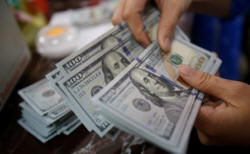|
Dollar plays catch-up
after stock market surge
 Send a link to a friend
Send a link to a friend
 [January 26, 2017]
By Patrick Graham [January 26, 2017]
By Patrick Graham
LONDON
(Reuters) - The dollar recovered from its worst run since August on
Thursday, rising 1 percent against the yen and around half a percent
against the euro and pound as investors refocused on the chances of
higher U.S. inflation and growth.
While equities and Treasury yields have continued to rise in the past
week, fueled by U.S. President Donald Trump's signals of new public
spending, the effect on the dollar has been offset by concerns about
other sections of his policy mix.
Some downbeat signals out of Japan and another burst higher in U.S.
government bond yields were enough to draw more buyers back into the
greenback as U.S. traders arrived at their desks on Thursday.
"Obviously there has been this oscillation between euphoria over the
macro data and trade protectionism fears," said Kamal Sharma, a
strategist with Bank of America Merrill Lynch in London.
"But we have argued this week could be the moment to start reinstating
some long dollar positioning, particularly against the yen. There may be
a catch-up in the yields in these moves (this morning); Treasury yields
have risen quite sharply."

Currency market players have offered a variety of explanations for the
dollar's weakness, from concerns about Trump's protectionist bent to his
warning over the currency's strength and worries about his approach to
geopolitical and social issues.
Either way, the squeeze on the huge bets on the dollar built up at the
end of last year has taken many by surprise.
"Positioning does seem to have overtaken the dollar bull arguments and
there is an issue of credibility with Trump," said Richard Benson,
co-head of portfolio investment at currency fund Millennium Global in
London.
"It really has just been a position annihilation."
Speculators have gradually cut their net bets on a stronger dollar from
$25.43 billion in the week ending Jan. 3 to $24.44 billion in the week
to Jan. 17, data from the Commodity Futures Trading Commission and
calculations by Reuters show.
[to top of second column] |

An employee of a bank counts US dollar notes at a branch in Hanoi,
Vietnam May 16, 2016. REUTERS/Kham

Data from the sector's biggest banking player Citi suggested that
squeeze was already deeper last week, driven by selling by leveraged
speculative investors.
The dollar index gained around 0.4 percent on the day on Thursday,
having hit a seven-week low of 99.793 in Asian trading. It rose 0.5
percent to as high as $1.0688 against the euro and 1 percent to 114.48
yen.
PRO-BUSINESS
If protectionism is the issue with Trump, it has not shown up in the
currencies of some of the Asian exporting economies that, theoretically,
should be most exposed.
The Singapore dollar dipped with the yen on Thursday but is trading
around its highest since mid-November. The Korean won hit its highest
since Nov. 10 in Asian trading. Mexico's peso strengthened to a
three-week high of 20.9300 pesos on Wednesday.
Among the group of G10 developed world currencies, the biggest gainer of
the past fortnight has been sterling, up almost 6 percent from troughs
hit on Jan. 16. It trimmed those gains after another solid reading of
fourth quarter growth to stand half a percent lower on the day at
$1.2570.
"It's been clear for some time that the UK economy maintained
exceptionally strong momentum in the second half of 2016 ... The
question is, what happens next?" said Ranko Berich, an analyst at
corporate broker Monex Europe.
"The latest retail sales data shows a slowdown in spending, and
inflation is only just beginning to bite. This all adds up to a
potential slowdown in the economy this year."
(Editing by Mark Heinrich)
[© 2017 Thomson Reuters. All rights
reserved.] Copyright 2017 Reuters. All rights reserved. This material may not be published,
broadcast, rewritten or redistributed.
 |